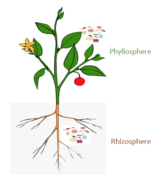| Part of a series on |
| Microbiomes |
|---|
 |

A holobiont is an assemblage of a host and the many other species living in or around it, which together form a discrete ecological unit through symbiosis,[2] though there is controversy over this discreteness. The components of a holobiont are individual species or bionts, while the combined genome of all bionts is the hologenome. The holobiont concept was initially introduced by the German theoretical biologist Adolf Meyer-Abich in 1943,[3] and then apparently independently by Dr. Lynn Margulis in her 1991 book Symbiosis as a Source of Evolutionary Innovation.[2] The concept has evolved since the original formulations.[4] Holobionts include the host, virome, microbiome, and any other organisms which contribute in some way to the functioning of the whole.[5][6] Well-studied holobionts include reef-building corals and humans.[7][8]
- ^ Brooks AW, Kohl KD, Brucker RM, van Opstal EJ, Bordenstein SR (November 2016). "Phylosymbiosis: Relationships and Functional Effects of Microbial Communities across Host Evolutionary History". PLOS Biology. 14 (11): e2000225. doi:10.1371/journal.pbio.2000225. PMC 5115861. PMID 27861590.
 Material was copied from this source, which is available under a Creative Commons Attribution 4.0 International License.
Material was copied from this source, which is available under a Creative Commons Attribution 4.0 International License.
- ^ a b Margulis L, Fester R (1991). Symbiosis as a Source of Evolutionary Innovation. MIT Press. ISBN 9780262132695.
- ^ Baedke J, Fábregas-Tejeda A, Nieves Delgado A (2020). "The holobiont concept before Margulis". J Exp Zool (Mol Dev Evol). 334 (3): 149–55. doi:10.1002/jez.b.22931. PMC 212183. PMID 3294806.
- ^ Cite error: The named reference
Theis2016was invoked but never defined (see the help page). - ^ De Weger LA, van der Vlugt CI, Wijfjes AH, Bakker PA, Schippers B, Lugtenberg B (June 1987). "Flagella of a plant-growth-stimulating Pseudomonas fluorescens strain are required for colonization of potato roots". Journal of Bacteriology. 169 (6): 2769–73. doi:10.1128/jb.169.6.2769-2773.1987. PMC 212183. PMID 3294806.
- ^ Vandenkoornhuyse P, Quaiser A, Duhamel M, Le Van A, Dufresne A (June 2015). "The importance of the microbiome of the plant holobiont". The New Phytologist. 206 (4): 1196–206. doi:10.1111/nph.13312. PMID 25655016.
- ^ Cite error: The named reference
Knowlton2003was invoked but never defined (see the help page). - ^ Cite error: The named reference
Kramer2015was invoked but never defined (see the help page).